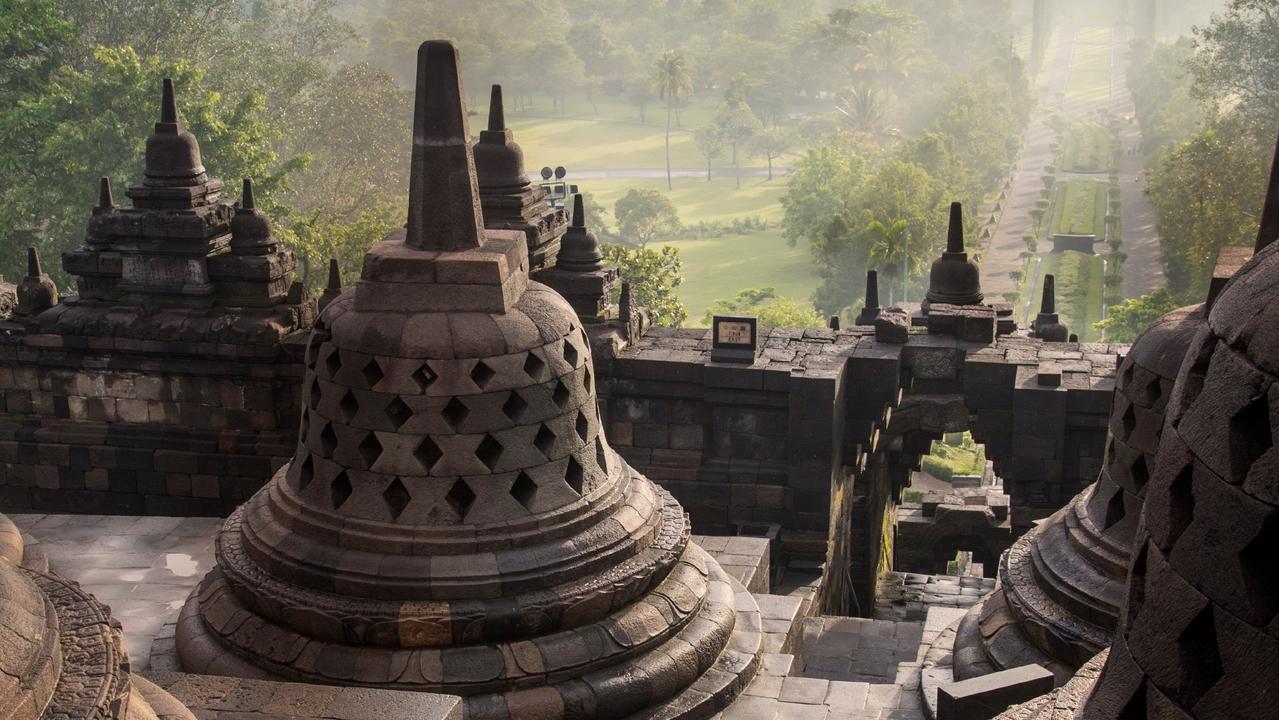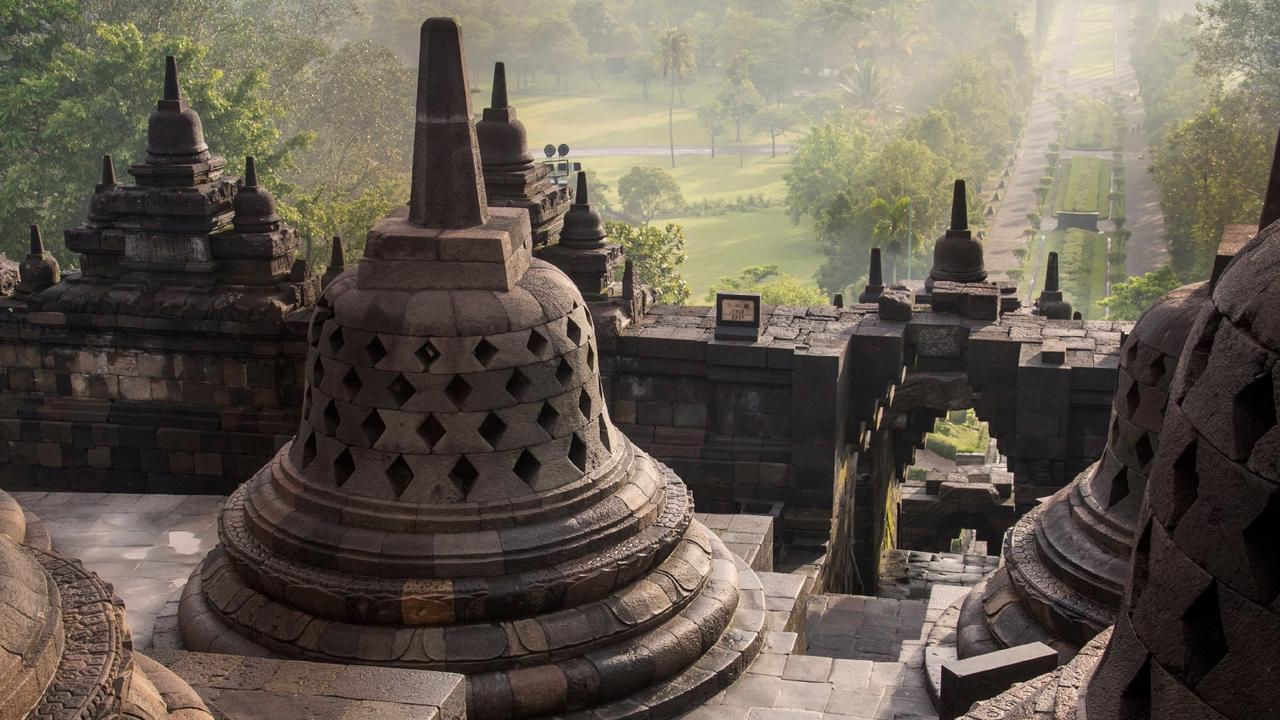Architect’s marvels: Russia; Java; Spain; Brazil; Azerbaijan; China; Poland
Journey to the world’s best-designed structures, old and new and marvellous.

Journey to the world’s best-designed structures, old and new and marvellous.
1: BOROBUDUR (9th century)
Gunadharma Magelang, Central Java, Indonesia
Rising like a mirage out of dazzling paddy fields, Java’s Borobudur is a whopping wonder. It’s an enormous Buddhist complex that hosts a stack of superlatives: biggest Buddhist monument; 504 statues of the Buddha; 1460 narrative panels. Indeed, here is the largest and most complete ensemble of Buddhist reliefs in the world. With a spectacular location in Java’s Kedu Valley, the complex has survived earthquakes, volcanic eruptions and war to remain a place of pilgrimage and prayer.
2: St BASIL’S CATHEDRAL (1555)
Postnik Yakovlev/Ivan the Terrible
Moscow, Russia
This is the symbol of Russia, a charming conversation between nine colourful domes. But it’s a bit more warlike than it seems. Hard by Red Square, the cathedral was built by Ivan the Terrible to commemorate the invasion of Kazan. Horrible fake history also has it that Ivan blinded its creator, Postnik Yakovlev, so that he couldn’t make another. What is true is that religion was banned here during communist rule and it became part of Moscow’s State Historical Museum. Fear not. If you say a prayer now, you won’t end up in a gulag.
3: THE GUGGENHEIM MUSEUM (1997)
Frank Gehry
Bilbao, Spain
Two decades ago American architect Frank Gehry’s titanium-scaled masterwork kickstarted a whole spree called the Bilbao Effect, in which cities would recover from economic doldrums by way of glittering new arts centres, or “icons’’, if you will. It was an immediate hit. As well as a gleaming exterior rising like a great fish from a river, the museum’s interiors are as dramatic as the astonishing tumble of intersecting titanium panels atop. Tourists came, Bilbao was revived, and although much copied, the Guggenheim remains fresh.
4: NITEROI CONTEMPORARY ART MUSEUM (1996)
Oscar Niemeyer
Niteroi, Brazil
Brazil is Oscar Niemeyer. The late architect designed the capital Brasilia, and his Niteroi Contemporary Art Museum, conceived when the maestro was 89, is similarly space age, with a saucer-like structure poised over Guanabara Bay, a reflecting pool, a curvy red concrete outdoor ramp winding 98m and, as Niteroi is part of the Rio de Janeiro metropolitan area, a nearby beach. Inside the museum, which locals refer to as the UFO, all the furnishings are by Oscar’s daughter Anna Maria.
5: BEIJING NATIONAL STADIUM (BIRD’S NEST) (2003-07)
Herzog & de Meuron and CAG
Beijing, China
Olympic Games tend to leave a mixed architectural legacy. Some are good, others iffy. The Bird’s Nest, the centrepiece of the 2008 Summer Olympics, is one of the former, and with artist Ai Weiwei on board, was the icon of the Games. The design was inspired by Chinese ceramics, and those sinuous steel beams hide supports for the retractable roof. The stadium fell into disuse, but now with a mall and concerts, the Bird’s Nest will live to tangle once more.
6: HEYDAR ALIYEV CENTRE (2007-12)
Zaha Hadid
Baku, Azerbaijan
Oil-rich Azerbaijan is keen to out-wow the Gulf states from its out-there location on the Caspian Sea. So mega-starchitect Zaha Hadid won the competition to design the ruling Aliyev family’s museum, and this is the incredible result. The sensational view is from the south, where the vast form rises like a peaking graph (one of Hadid’s signature “biomorphic’’ curves), while inside, the wide white stairs and misty sightlines make you think you’ve gone to high-drama heaven, somewhat dwarfing the exhibits.
7: THE CROOKED HOUSE (KRZYWY DOMEK) (2004)
Szotynscy & Zaleski
Spot, Poland
As if to show how the mundane can become marvellous, the Crooked House is a building on a normal shopping street in this seaside town, and it hosts a mall with restaurants, shops and businesses. Rather than go the normal route, however, the architects, inspired by Polish children’s book illustrator Jan Marcin Szancer, went for a wonky fairytale look, distorting all the house’s lines to bizarre and comic effect. Spot’s tourists love it, although some still fear entering.
8: ROMAN BATHS
Roman origin (60-70AD); John Wood, the Elder and Younger (1894-7)
Bath, England
Never has water cascaded down the ages so exquisitely. Once the Roman city of Aquae Sulis (the waters of Sulis), golden-stoned Bath is the finest Georgian set-piece in the world, and the Roman Baths are its centrepiece. They include the central Sacred Spring, surrounded by Georgian splendour from master builders John Wood the Elder and Younger, and the Temple, the Bath House, and a museum. You can’t swim in the baths’ frightening green water, but its sulphurous smell will likely put you off, in any case.
9: HALLGRIMUR CHURCH (1945)
Gudjon Samuelsson
Reykjavik, Iceland
This astonishing church is the centrepiece of Reykjavik, its sentinel, mascot and sanctuary. Coming on like a rocket, its skyward concrete thrust never fails to impress. Named after the 17th-century clergyman Hallgrimur Petursson, architect Gudjon Samuelsson was inspired by the basalt in the landscape, which cools to form organ pipe-like flutes. Indeed, within is a vast pipe organ and there’s an organ festival every year. History buffs will like the statue of Leifur Eiriksson (c970-c1020), the first European to discover America in 1000AD. Don’t dare contradict this.
BEST BEDS
10: PARKROYAL ON PICKERING (2013)
WOHA
Singapore
This has to be one of the mightiest flowerpots in the world. Covered in tropical plants — on balconies and terraces inspired by paddy fields and geological formations — this award-winning hotel brings a verdant splash into the urban fabric of Singapore. Every guestroom in the hotel has a green view, and amid the plants are stones, vines and ponds to satisfy the inner Tarzan, as well as a 300m-long garden walk high above street level, all literally topped with an infinity pool and relaxing cabanas. It’s the perfect marriage of city and country; parkroyalhotels.com.
This is an edited extract from Amazing Architecture: A Spotter’s Guide (Lonely Planet, $14.99). Pictures: Getty Images, Shutterstock.

